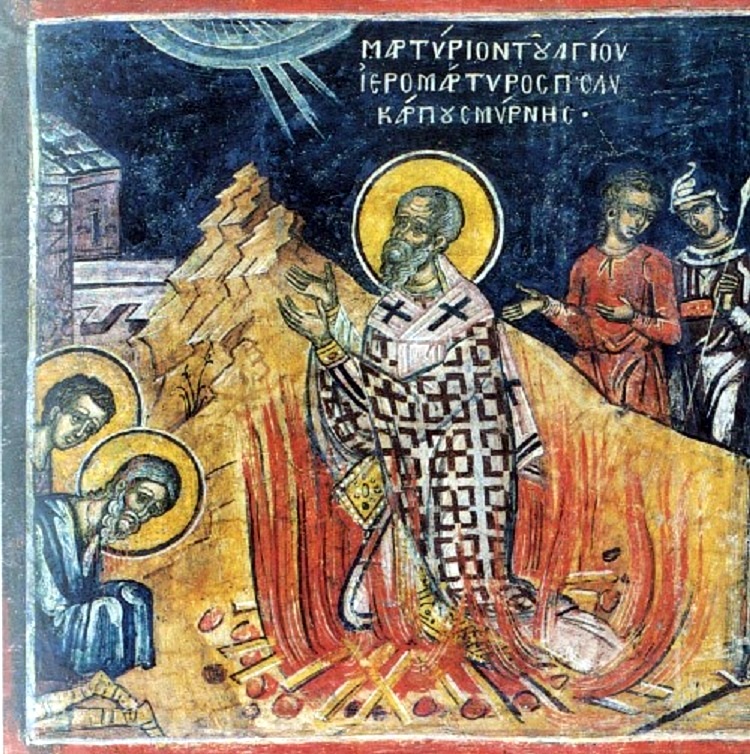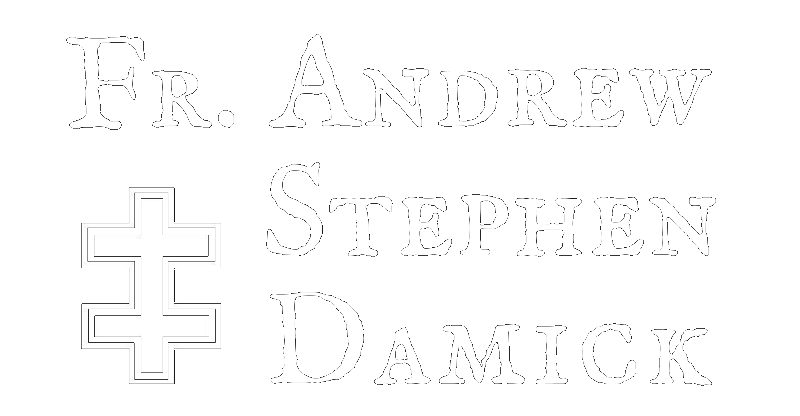
Today is the beginning of Great Lent for most Orthodox Christians (a handful of Western Rite Orthodox Christians will begin with their Ash Wednesday the day after tomorrow), and I’ve decided to try my hand at doing 40 days of blogging—posting at least once a day from today through the Friday before Lazarus Saturday. This is my first post for Great Lent.
Today I am thinking about bones.
Bones are the palpable remnant of a human person after he has left this earthly life. They also are what undergirds our physical experience here. We use bones as a metaphor for solidity and substance and for what we feel deeply. And they also bring to mind that we shall all die.
And bones are all that was left of Polycarp after they burned him.
St. Polycarp is celebrated today, on February 23, and one of the reasons he stands out in my mind is that he is one of the only saints that a member of my family has ever asked me about (except for my wife and children and my father-in-law’s family, my family are all Evangelicals). I honestly can’t remember the context of the conversation or even the content of the question.
Today is also the first day of Great Lent—Clean Monday or Pure Monday—and so Orthodox thoughts are all turned for the moment toward our efforts for the next forty days (followed by Holy Week), wherein we as the Church seek to be purified by God through prayer, fasting and almsgiving, both in preparation for Holy Pascha (Easter) and also to try to bring our spiritual lives to an overall higher level. It is an ecclesial event—we do not generally “pick” something to “give up for Lent,” but rather try as best as we can to conform ourselves to this effort as a community.
Polycarp’s martyrdom is notable as one of the first martyr stories told after the narrative in the canonical Scriptures. A disciple of the Apostle John (he was friends with Ignatius of Antioch, his fellow-disciple under John) and the bishop of Smyrna (modern Izmir in Turkey), he was killed by the Roman authorities in AD 167 at the age of 87 for the crime of refusing to worship the emperor. They first tried to burn him alive, which didn’t seem to work, and then they stabbed him with a dagger, which did finally kill him, and then his body was burned, in defiance of his fellow Christians who had wanted to bury him.
The detail which always stands out for me is this one, which happens after his body had been burned:
The centurion then, seeing the strife excited by the Jews, placed the body in the midst of the fire, and consumed it. Accordingly, we afterwards took up his bones, as being more precious than the most exquisite jewels, and more purified than gold, and deposited them in a fitting place, whither, being gathered together, as opportunity is allowed us, with joy and rejoicing, the Lord shall grant us to celebrate the anniversary of his martyrdom, both in memory of those who have already finished their course, and for the exercising and preparation of those yet to walk in their steps.
It’s an earthy detail, this gathering up of bones “more precious than the most exquisite jewels, and more purified than gold,” and it’s a detail which stands for me in stark contrast to the kind of religion which now defines American Evangelicalism and indeed most of Protestantism. If you enter any Orthodox Church or older Roman Catholic churches, there is a good chance you might find some actual bones on display somewhere—we have two such relics out for veneration at my parish (one of St. Paul and another of St. Raphael of Brooklyn). But it would be tremendously weird to encounter that kind of thing down at Crosspointe Community Church or First Presbyterian Church or God’s Holiness Bible Church.
But most Christians throughout history (and even now) would not find this weird.
I likewise thought of the earthiness of the faith I practice this past week and yesterday evening at Forgiveness Vespers, for the same reason that will be manifest this First Week of Lent especially but also all throughout Lent: Prostrations. Bows. Making the sign of the cross. Receiving Holy Communion. Fasting. And so on.
Orthodox Christians will prostrate, eat, not eat, bow, cross, receive, be anointed, kiss, carry icons, cense and process their way through Great Lent, Holy Week and Pascha. Sometimes, we may even get a bit winded (especially for those who are out of shape like I am). It’s all quite earthy, quite palpable, quite physical.
Again, this may seem weird to most of my Protestant friends and family. And it will probably seem a bit much to most American Catholics, through their co-religionists elsewhere would be right at home. I can recall the beautiful “old world” style Catholicism (that was the phrase my father used for it) I saw when I lived on Guam in the late ’80s.
What probably stands out in most of modern Protestantism is actually that all this level of palpable physicality is in fact the norm for most religion throughout time—not just for most Christians, but for most human beings of whatever religion. In other words, Protestantism is the first major religious movement in the world that has de-emphasized the physical.
That a sense of materiality is the norm for spirituality is not in itself an argument on its behalf—after all, perhaps it’s the de-physicalization of religion that’s right while the rest are wrong. (The overwhelming evidence for a very physical Christianity early on should at least be an argument in favor of its authority for Christians. Then again, maybe your particular group teaches that the early Church got things wrong.) And I’m not offering an argument here, really.
Instead, I’d just like to offer this impression: We are human persons. We have souls. We have minds. We have emotions. And we also have bodies. Even if you are not a Christian who believes that God created the human body, that human beings are embodied is undeniably apparent. And if religion really is about the whole human person, it’s going to be physical. It’s going to be earthy. It’s going to be bodily.
It’s going to be about bones.



Orthodox CrossFit? Bring it ON!
Thank you, Father. One of the things that is being brought home to me (and that drew me to Orthodoxy), as I seek to grown in and learn more about Orthodoxy, is the humility embodied within the practices. It is no small thing to prostrate yourself before another and ask forgiveness or to kiss an icon or a hand out of respect. I have yet to take part in these things–I watched the other parishioners last night during forgiveness Vespers–but I am very aware of them. There is a great deal of the physical in Orthodoxy and I find that both exciting and illuminating. Many thanks for this article!
Yes! Take that, Plato! 🙂
“In other words, Protestantism is the first major religious movement in the world that has de-emphasized the physical.”
I’ve at times heard Pentecostals dissociate themselves from the term Protestant, and indeed, I would say that charismatic worship is very kinesthetic (depending on the group, one may see any combination of the following : dancing, shaking, lifting of one’s hands, spiritual drunkenness, speaking in tongues, etc… I’ve even heard of “tokin’ the ghost” ). The type of life these acts pattern our hearts toward, however, may differ from that of “old world” Christian norms. Would you consider Pentecostals to be separate from the majority of Protestantism in this regard?
In some ways, yes, though it’s a newly-created tradition made in reaction rather than something with continuity with Christian history.
A very nice piece of writing and thought.
I’m an Evangelical with Orthodox sympathies. The physicality of Orthodox practice is very appealing to me. Similarly, I think emotions get short changed in more Reformed circles. I’m glad to be known as a whole person.
Fr. Andrew,
Great post. Sts. Polycarp and Ignatius of Antioch helped me to become Orthodox, and they both remain very dear to me. St. Polycarp’s body, a true temple of the Holy Spirit, was even venerated before his martyrdom!
“And when the funeral pile was ready, Polycarp, laying aside all his garments, and loosing his girdle, sought also to take off his sandals,— a thing he was not accustomed to do, inasmuch as every one of the faithful was always eager who should first touch his skin. For, on account of his holy life, he was, even before his martyrdom, adorned with every kind of good.” (Martyrdom of Polycarp)
This reminds me of how the Faithful venerated Christ and the Apostles, even a touch was enough to impart grace.